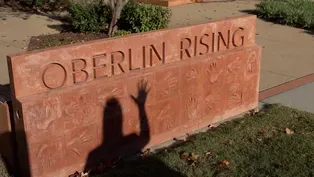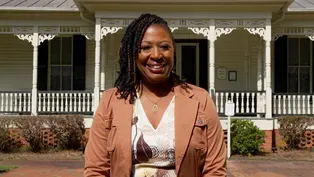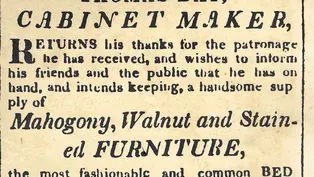
Museum of the Cape Fear
Clip: Season 21 Episode 21 | 4m 44sVideo has Closed Captions
The Museum of the Cape Fear displays the history of the Fayetteville area.
The Museum of the Cape Fear displays the history of the Fayetteville area from Native Americans to the dawn of the textile era.
Problems with Closed Captions? Closed Captioning Feedback
Problems with Closed Captions? Closed Captioning Feedback
North Carolina Weekend is a local public television program presented by PBS NC

Museum of the Cape Fear
Clip: Season 21 Episode 21 | 4m 44sVideo has Closed Captions
The Museum of the Cape Fear displays the history of the Fayetteville area from Native Americans to the dawn of the textile era.
Problems with Closed Captions? Closed Captioning Feedback
How to Watch North Carolina Weekend
North Carolina Weekend is available to stream on pbs.org and the free PBS App, available on iPhone, Apple TV, Android TV, Android smartphones, Amazon Fire TV, Amazon Fire Tablet, Roku, Samsung Smart TV, and Vizio.
Providing Support for PBS.org
Learn Moreabout PBS online sponsorshipI'm here with Megan Maxwell, Curator of Education at the Museum of the Cape Fear.
Megan, you actually have a house on this property, and that's not really usual for a museum.
Who owns this house?
Or who did own the house?
- Right.
So it is part of our museum complex.
We have the museum and then this is a historic house museum.
It was owned by a gentleman called E.A.
Poe, and that does stand for Edgar Allan Poe, but it is not the famous writer.
Our Mr. Poe owned a brick company in town.
He was a local businessman, politician.
And this is the area of Fayetteville called Haymount, where a lot of the local businessmen were building homes right around the turn of the 20th century here in Fayetteville.
So this house basically represents what life was like right around 1900 for an upper class family here in Fayetteville.
- Well, I'd love to take a tour.
- Yeah, sure.
We can go on inside.
- Okay.
- [Megan] So this is the parlor.
This is the formal living room of the house.
This is where special events took place.
If any of the daughters had a gentleman caller, this is where they would be hosted.
Weddings took place in here.
The three oldest daughters got married in here.
Anytime somebody died, this is where you would be laid out.
So funerals took place in here as well.
And Deb, another interesting thing about the house is the lighting.
The light fixture in here is actually original to the home.
So this was purchased by E.A.
Poe when the house was constructed.
It's a gas/electric combination fixture.
So originally additional brass arms would've come up out of it this way, and a globe would've been here, and the gaslight would've shined through that.
He knew electricity was coming soon, but they didn't have it just yet.
So he was definitely forward thinking when he installed the combination fixtures in the house.
- That's just beautiful.
- [Megan] So this is the dining room.
The table and chairs did belong to the Poe family, so they would've eaten all their meals in here together.
The most important meal of the day at the time would have been lunch, which we here in the South called dinner.
And Mr. Poe would come home from the brick company, and they would all have their family dinner together.
The Poe were a wealthy family, so they did have domestic servants, and one of those servants was a cook named Nancy Graham, and she would've prepared all of the meals for the family in the kitchen.
So Deb, this is the nurse's room, and the Poe were a wealthy family, so they did have domestic servants and in the South, domestic servants are primarily going to be black.
In this case, Jenny, who was a nurse or what we would call a nanny for the family, was a young black woman.
This would've been her room.
So she had a separate room, and lived with the family right next to the nursery.
So her primary job would've been to take care of the children in the nursery.
And we know about Jenny because we have a copy of Lily's diary from when she was a child growing up in the house and she does mention Jenny a lot.
And we found this photo in one of the family photo albums.
So it is a picture of Jenny here, and then this is Nancy, the Cook, who I mentioned in the dining room.
- We've been able to preserve so much, and capture so much of their story in the history.
It's really fascinating.
[soft instrumental music] - So Deb, this is our temporary exhibit gallery.
Right now we have a special exhibit.
It's called "17 Men.
Portraits of the 25th U.S.
Colored Troops."
And the significance of this exhibit, these portraits were done by Shayne Davidson.
She is a Genealogist and Illustrator.
She discovered a photo album when she was doing a family tree for a friend.
The photo album was only about this big, and it had these portraits in it.
10 types and ambrose types of these 17 men who served with the 25th U.S.
Colored Troops.
To honor them, she created biographies, and also these life-size portraits that you see here in the gallery.
- [Deborah] These are so powerful.
The Museum of the Cape Fear Historical Complex is at 801 Arsenal Avenue in Fayetteville, and they're open Tuesday through Saturday from 10:00 AM to 5:00 PM, and Sunday from one to five.
To find out more, give them a call at [910] 500-4240.
Or visit them online at MuseumoftheCapeFear.ncdcr.gov.
Video has Closed Captions
Relive your childhood playing vintage arcade games in Forest City. (4m)
Video has Closed Captions
Deborah Holt Noel traces the revitalization of the Black Oberlin neighborhood in Raleigh. (6m 1s)
Video has Closed Captions
Join us as we head to notable historic sites and destinations across the state. (26s)
Thomas Day State Historic Site
Video has Closed Captions
Learn about early furniture maker Thomas Day at this new site in Milton. (5m 10s)
Video has Closed Captions
We explore Fort Defiance, a home built by Revolutionary War hero William Lenoir in 1792. (3m 40s)
Providing Support for PBS.org
Learn Moreabout PBS online sponsorshipSupport for PBS provided by:
North Carolina Weekend is a local public television program presented by PBS NC
















